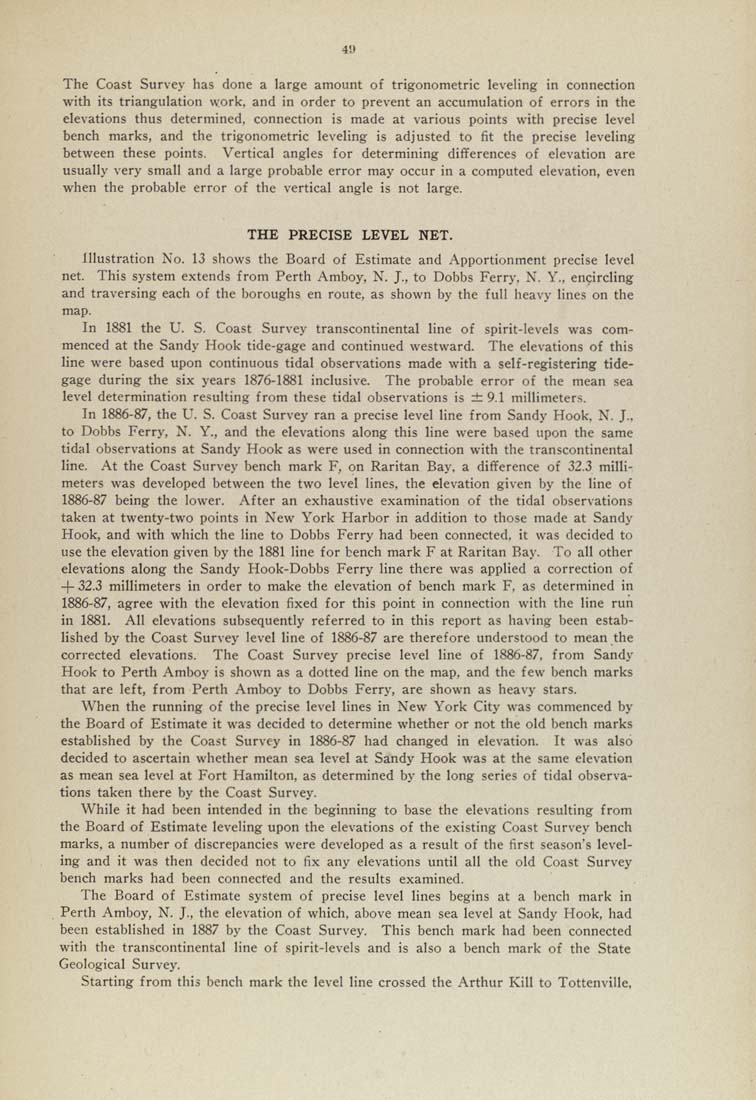The Coast Survey has done a large amount of trigonometric leveling in connection
with its triangulation work, and in order to prevent an accumulation of errors in the
elevations thus determined, connection is made at various points with precise level
bench marks, and the trigonometric leveling is adjusted to fit the precise leveling
between these points. Vertical angles for determining differences of elevation are
usually very small and a large probable error may occur in a computed elevation, even
when the probable error of the vertical angle is not large.
THE PRECISE LEVEL NET.
Illustration No. 13 shows the Board of Estimate and Apportionment precise level
net. This system extends from Perth Amboy, N. J., to Dobbs Ferry, N. Y., eni;;ircling
and traversing each of the boroughs en rotite, as shown by the full heavy lines on the
map.
In 1881 the U. S, Coast Survey transcontinental line of spirit-levels was com¬
menced at the Sandy Hook tide-gage and continued westward. The elevations of this
line were based upon continuous tidal observations made with a self-registering tide-
gage during the six years 1876-1881 inclusive. The probable error of the mean sea
level determination resulting from these tidal observations is ±9.1 millimeters.
In 1886-87, the U. S. Coast Survey ran a precise level line from Sandy Hook, N. J„
to Dobbs Ferry, X. Y., and the elevations along this line were based upon the same
tidal observations at Sandy Hook as were used in connection with the transcontinental
line. At the Coast Survey bench mark F, on Raritan Bay. a difference of 32,3 milli¬
meters was developed between the two level lines, the elevation given by the line of
1886-87 being the lower. After an exhaustive examination of the tidal observations
taken at twenty-two points in New York Harbor in addition to those made at Sandy
Hook, and with which the line to Dobbs Ferry had been connected, it was decided to
use the elevation given by the 1881 line for bench mark F at Raritan Bay. To all other
elevations along the Sandy Hook-Dobbs Ferry line there was applied a correction of
4" 32,3 millimeters in order to make the elevation of bench mark F, as determined in
1886-87, agree with the elevation fixed for this point in connection with the line run
in 1881. All elevations subsequently referred to in this report as having been estab¬
lished by the Coast Survey level line of 1886-87 are therefore understood to mean the
corrected elevations. The Coast Survey precise level line of 1886-87. from Sandy
Hook to Perth Amboy is shown as a dotted line on the map, and the few bench marks
that are left, from Perth Amboy to Dobbs Ferry, are shown as heavy stars.
When the running of the precise level lines in New York City was commenced by
the Board of Estimate it was decided to determine whether or not the old bench marks
established by the Coast Survey in 1886-87 had changed in elevation. It was also
decided to ascertain whether mean sea level at Sandy Hook was at the same elevation
as mean sea level at Fort Hamilton, as determined by the long series of tidal observa¬
tions taken there by the Coast Survey.
While it had been intended in the beginning to base the elevations resulting from
the Board of Estimate leveling upon the elevations of the existing Coast Survey bench
marks, a number of discrepancies were developed as a result of the first season's level¬
ing and it was then decided not to fix any elevations until all the old Coast Survey
bench marks had been connected and the results examined.
The Board of Estimate system of precise level lines begins at a bench mark in
. Perth Amboy, N. J., the elevation of which, above mean sea level at Sandy Hook, had
been established in 1887 by the Coast Survey, This bench mark had been connected
with the transcontinental line of spirit-levels and is also a bench mark of the State
Geological Survey,
Starting from this bench mark the level line crossed the Arthur Kill to Tottenville,
|








